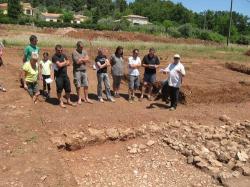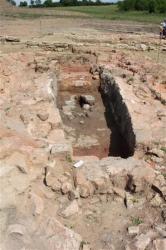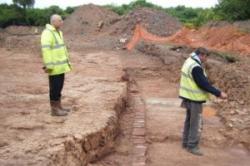- 23 MAI
- CHINE – Hanguguan Pass - Archaeologists in central China's Henan Province said they have found an ancient road and several inscriptions near the Hanguguan Pass, a road used by trading caravans during China's dynastic period. The relics were discovered on a cliff 200 meters east of the Guan Tower in the village of Dongguan, where part of the pass is located. About 100 meters of road were uncovered. The inscriptions found were incomplete, but archaeologists were able to decipher characters indicating that they were created during the Tang Dynasty (AD 618-907). Historians said since the road served as a passage to the ancient Silk Road, the new finds might qualify to be listed on the World Heritage List. The Hanguguan Pass was originally built before the Qin Dynasty (221-206 BC) near the city of Lingbao. During the Han Dynasty (202 BC - AD 220), the pass was relocated to nearby Xin'an County. It was militarily and economically significant at that time, as it linked Luoyang and Xi'an, two of China's ancient capitals.
http://www.kaogu.cn/en/detail.asp?ProductID=2843
- FRANCE – Niort - C y gist le corps de Catherine Barbault veuve Mornay… marchand décédé le 23 septembre 1672 Priez Dieu… Pour une surprise, c’est une belle surprise ! Hier après-midi, alors qu’elles mordaient à belles dents dans le macadam de la rue Victor-Hugo, les pelleteuses actuellement à la manœuvre sur le grand chantier du centre-ville ont dû freiner des quatre fers… Pour mettre méticuleusement au jour, à seulement 1,20 mètre de profondeur, six sarcophages en excellent état de conservation. Ou plus exactement six demi-sarcophages soigneusement alignés côte à côte, perpendiculairement à la rue. Il ne s’agit en effet que des couvercles de sépultures datant de la seconde moitié des XVIIe et XVIIIe siècles selon ce que révèlent certaines des inscriptions gravées dans la pierre et pour la plupart en excellent état de conservation. Pierre Mornay, veuve Martin, Charbonneau, Brelay, 1791… Ce ne sont pas des tombes et il n’y a aucun squelette ni quoi que ce soit sous ces couvercles de sarcophage. Issus de quelque cimetière avoisinant, ils ont été utilisés lors de la construction, au milieu du XIXe siècle, de l’égout ovoïde par lequel s’évacuent les eaux usées et de pluie du centre-ville. Construit en pierre, cet égout de grande taille, dans lequel un homme peut tenir debout, a donc été coiffé à cet endroit par ces pierres tombales.
http://www.niort.maville.com/actu/actudet_-Les-pelleteuses-tombent-sur-six-sarcophages_loc-1801022_actu.Htm
- FRANCE –  Pas Redon - Cette campagne de fouilles, débutée en avril, se terminera en juillet. Inscrite dans le cadre des travaux d'aménagement du quartier du Pas-Redon, elle a permis de mettre à jour deux hectares de vestiges archéologiques sur les sept bientôt lotis. Les traces d'occupation resurgies de la gangue remontent au Ier siècle avant notre ère. On y trouve une voie romaine qui dessert plusieurs bâtis à vocation agricole (culture de la vigne, de l'olivier...) et artisanale (fours de tuiliers et de potiers). Des habitations situées à flanc de colline et quelques sépultures de la fin du IVe siècle parachèvent cet ensemble qui formerait un vicus. Un peu plus loin, une villa appartenant sans doute à un personnage influent complète le tableau. D'ici à quatre mois, ces découvertes seront détruites ou recouvertes. Le programme urbanistique reprendra ses droits, à l'instar des villes qui ne sont bien souvent qu'un empilement de bâtis de différentes époques. Seul le mausolée sera préservé, mais recouvert.
Pas Redon - Cette campagne de fouilles, débutée en avril, se terminera en juillet. Inscrite dans le cadre des travaux d'aménagement du quartier du Pas-Redon, elle a permis de mettre à jour deux hectares de vestiges archéologiques sur les sept bientôt lotis. Les traces d'occupation resurgies de la gangue remontent au Ier siècle avant notre ère. On y trouve une voie romaine qui dessert plusieurs bâtis à vocation agricole (culture de la vigne, de l'olivier...) et artisanale (fours de tuiliers et de potiers). Des habitations situées à flanc de colline et quelques sépultures de la fin du IVe siècle parachèvent cet ensemble qui formerait un vicus. Un peu plus loin, une villa appartenant sans doute à un personnage influent complète le tableau. D'ici à quatre mois, ces découvertes seront détruites ou recouvertes. Le programme urbanistique reprendra ses droits, à l'instar des villes qui ne sont bien souvent qu'un empilement de bâtis de différentes époques. Seul le mausolée sera préservé, mais recouvert.
http://www.varmatin.com/article/gapeau/pas-redon-le-public-sur-les-traces-de-loccupation-gallo-romaine
- FRANCE – Kochersberg - Un an et demi de recherche, six à sept communes concernées dans le Kochersberg, 14 chantiers d’archéologie préventive, soit une opération au kilomètre, 23 hectares fouillés, le nombre de sites découverts fait de la construction de la LGV Est européenne l’une des plus importantes opérations archéologiques jamais réalisées en France. Réalisées par une trentaine d’archéologues de l’INRAP (institut national de recherches archéologiques préventives), les fouilles, en fait, ont mis au jour des vestiges importants qui racontent l’histoire de l’occupation du sol depuis le néolithique. « Nous avons notamment découvert une quarantaine de sépultures, enterrées dans des silos, dans des positions parfois invraisemblables : cela montre qu’il y a eu un phénomène de crise, des violences » poursuit l’archéologue. Plus banals et fréquents, les tessons de céramique racontent, eux aussi, le passé très lointain. « Après la mise au jour, on stabilise les matériaux, on remonte les vases à partir des morceaux épars et on les remet en valeur. La peinture et la décoration nous permettent ensuite de les dater assez précisément ». Même les graines découvertes, comme l’orge ou le millet, livrent des informations sur le mode de vie de ces populations qui, depuis le néolithique, ont occupé cette région, l’ont déboisée avant de la transformer en terres fertiles agricoles.
http://www.lalsace.fr/actualite/2011/05/23/sous-les-rails-l-histoire-des-hommes
- FRANCE -  Montmorot - C’était un moment qui a fasciné les amateurs et les curieux d’Histoire. L’occasion unique de découvrir la saline du XVIII e siècle à Montmorot, découverte lors du chantier du contournement ouest de Lons-le-Saunier. Les journées de l’archéologie tombaient à pic. Un des vestiges du site : la chaudière permettant la précipitation du sel par évaporation / Photo Laurie Bouclet
Montmorot - C’était un moment qui a fasciné les amateurs et les curieux d’Histoire. L’occasion unique de découvrir la saline du XVIII e siècle à Montmorot, découverte lors du chantier du contournement ouest de Lons-le-Saunier. Les journées de l’archéologie tombaient à pic. Un des vestiges du site : la chaudière permettant la précipitation du sel par évaporation / Photo Laurie Bouclet
http://www.leprogres.fr/jura/2011/05/23/400-personnes-autour-de-la-saline-decouverte-sur-le-chantier-du-contournement-de-lons-
- USA – St.Augustine - Somewhere around the area stretching from the Fountain of Youth to the Mission of Nombre de Dios, Kathleen Deagan hopes to find the fort built by Pedro Menendez de Aviles after he landed here in 1565. Menendez's fort wasn't the type with towers and crenellations, but rather one made of the materials at hand. In 1976 Deagan led her first field study at the site. "I had worked in St. Augustine before and I knew (the Fountain) was a Timucuan Indian site. That 1976 dig reinforced the facts of the Timucuan Indian habitation as foundations and artifacts came to light. But in 1985 another excavation led by Deagan turned up Spanish barrel wells, and the archaeologist knew what she had found that time wasn't a Native American town. She began researching, trying to identify who else had been at the site. Documents, location, artifacts and the settlement history led her to identify it as where Pedro Menendez de Aviles, the founder of St. Augustine, most likely set up his Spanish settlement in 1565. The Spanish needed to be able to defend themselves from attacks from the French who were already in the area. Menendez had been sent by the Spanish king to drive out those French colonists and formally claim Florida. When he first landed in September 1565, an entrenchment was dug for protection. In November, Menendez marked out a new fort before he left with part of his troops to capture French survivors at Cape Canaveral. In 1566 he had to put down a mutiny at St. Augustine. Then, while he was off exploring the Gulae region, the fort half burned on April 1. When he returned in May, Menendez decided to relocate the settlement and fort to Anastasia Island. A third fort was built in June 1566 incorporating part of the second April fort.
http://staugustine.com/news/local-news/2011-05-22/mystery-menendez
- INDE – Guwahati - The state directorate of archeology has a grand plan to preserve sattras, the historical monasteries that were built by the revered Vaishnava saint Srimanta Sankardev several hundred centuries ago to spread the message of peace and love. The directorate has also decided to set up 11 new heritage complexes at Majuli. "We are initiating the project with the Sri Sri Sridham Ramaraikuti sattra of Sattrasal in Dhubri, Sri Sri Pakhuriporiya sattra of Hatieye Khowa in Golaghat and Sri Sri Jorabari sattra in Sivasagar in the first stage.
http://timesofindia.indiatimes.com/city/guwahati/Rs-3-crore-for-sattra-preservation/articleshow/8529093.cms-
- ROYAUME-UNI –  Norton - Construction work on a new housing development in Runcorn has unearthed what are thought to be the final remains of the medieval village of Norton. Around 80 archaeological features have been found at the site near Lodge Farm, off Highgate Close, Norton village, since excavation began at the end of April. Archaeologists have unearthed shards of pottery they believe date from the 13th and 14th centuries, as well as the footings and post holes of former timber-framed houses close to site of the old village road. The site, which is around 700 square metres, was required to be excavated because it is in a location of archaeological interest and remains of medieval buildings, as well as pits containing prehistoric pottery, were found when the adjacent lot was excavated in the 1970s. The items recovered from the site are being analysed at the Oxford Archaeology North laboratory at Lancaster, where archaeologists will analyse the artefacts and carbon date organic samples. Jamie Quartermaine, senior project manager at Oxford Archaeology North, who has been leading the project, said: “This is almost the last surviving remains of the old medieval village of Norton on land that is beside the main thoroughfare of the village. We have found evidence of buildings in the form of post holes, where vertical timbers were set into the ground, and also shreds of medieval pottery.”
Norton - Construction work on a new housing development in Runcorn has unearthed what are thought to be the final remains of the medieval village of Norton. Around 80 archaeological features have been found at the site near Lodge Farm, off Highgate Close, Norton village, since excavation began at the end of April. Archaeologists have unearthed shards of pottery they believe date from the 13th and 14th centuries, as well as the footings and post holes of former timber-framed houses close to site of the old village road. The site, which is around 700 square metres, was required to be excavated because it is in a location of archaeological interest and remains of medieval buildings, as well as pits containing prehistoric pottery, were found when the adjacent lot was excavated in the 1970s. The items recovered from the site are being analysed at the Oxford Archaeology North laboratory at Lancaster, where archaeologists will analyse the artefacts and carbon date organic samples. Jamie Quartermaine, senior project manager at Oxford Archaeology North, who has been leading the project, said: “This is almost the last surviving remains of the old medieval village of Norton on land that is beside the main thoroughfare of the village. We have found evidence of buildings in the form of post holes, where vertical timbers were set into the ground, and also shreds of medieval pottery.”
http://www.24dash.com/news/housing/2011-05-23-Housing-excavation-uncovers-remains-of-medieval-village